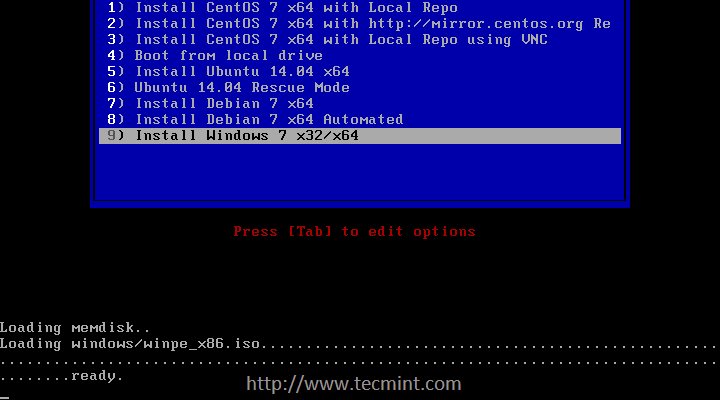Install Xp Pxe Boot
How to Network Boot Windows XP, Windows 7, Vista with Network Boot Software. And the same time, CCBoot supports install windows 7 via pxe boot.
Ive used PXE environments in the past, but mainly for personal projects and not in a large scale business environment.PXE boot has its advantages as well as disadvantages.Once the image is set up correctly you dont need to do much more then that, providing all the hardware is the same.One issue is network load, if all your users start their computers at 9:00am thats going to put a huge load on ur pxe server and will take ages to download the OS - this will need some thought if you have a lot of users who on an average day all start at the same time.Sorry i cant help much more then that. Justin are you asking what others use to (re)image computers to be deployed to the end user?If that's the case, we are currently using WDS to image our systems. The WDS server is not on the live network. I have it setup so that it is plugged into a gigabit switch and any computer that needs to be deployed is plugged into this switch.
Install Windows Xp Via Pxe Boot
The server then images the computer and when thats done we move the computer to the live network. I can't tell you how to setup a WDS server as we have a team of people that set that up for me. I hear it can be pretty simple though. Segregate from your 'live network'. Determine your need.
How many PC's will I be ghosting/imaging at a time. Setup a small environment (lab, workplace, testing/training area, etc.). Ensure you have preferably a GB switch in place and enough space/cabling to go around.Once the environment is setup, you can than start deploying your images to your machines. There is a vast amount of software that can be used to do this, both in Open Source and in Licensed.You want to segregate from the live network because more and more of these 'servers' are using multicast to enable multiple clients to be installed all at once. You don't want the extra load interfering with the entire network.


That's what I thought you meant. We used to use Clonezilla (free), but the problem is that it would only work on one model computer. It clones an original hardrive and then uses that image for all others. We use a few different models here so it wasn't the best option. The company went with WDS and it works for all the different configurations of computers we have. The only problem I have with it is that it puts a generic Windows install on the computer and then we have to go back and install drivers.
Not a big deal anymore as we created a batch file that is run shortly after imaging and it installs the specific drivers for the computers. We just start the batch file and walk away. I have never personally used PXE. I have used (1)GhostCast SErver, (2)WinPe w/ Imagex.(1)I setup a server and 24 port 10/100 switch off the main network. I first created the image on the 'test' box. Then I sysprep'd the image. Next I captured the image to the server with GhostCast.
Pxe Boot Server Windows 10
Whenever I needed to deploy the image on a new computer of the same type, I would just plug the new computer into the switch and GhostCast the image on to the new computer. Now I still had to join the computer to the domain after all that.(2)I used The WAIK (Windows automated installation kit) to setup a winpe deployment environment. First I created a winPE boot disk. At the same time I put imagex on the boot disk, as well as the wimscript.ini file. Imagex requires wimscript.ini in order to work properly.
Imagex is the file that captures the image of the system. Dont forget Sysprep is still used here.The first thing to do once you have created a WinPe boot disk with the imagex file and the wimscript.ini, is to sysprep the system. Once the system has been syspreped, make sure the winpe boot disk is in the cd rom drive and then boot from that disk. Then use imagex to capture the image of the syspreped system. WinPe and imagex can also be used to deploy images to a system.There is even more detail that I can divulge about WinPE and imagex, such as how to automatically join the computer to a domain with WinPe and Imagex.I have written up a walkthrough, If you would like more information or even the walkthrough please send a message to me.
I will not post my true email address in fear of spam/virus/the usual garbage. Fogproject looks very professional, I hadn't seen that one before.I actually recently tried to set up unattended installation (a solution I perfer to imaging) via 2 open source 'solutions' one called ANI and the other called unattended.If I remember correctly, the installation instructions fell somewhat short for unattended and with ANI there are no instructions for setting up PXE!
(only boot disks)Quite a shame, especially with ANI, as I like the look of their setup.Anyhow, I gaveup and set up RIS on our spare win 2k3 server, if you're interested the more useful pages about RIS are probably:And for how to add drivers to the distribution source:And for creating an answer file, you find deploy.cab on your XP CD (Or I think it is possible to download from microsoft). Inside it is the setup manager amongst other things, but the setup manager can be used to easily create an answer file.The benefit is only having to set it up once and because it is basically just running an installation you don't have to keep making new images for each new model of machine you get.